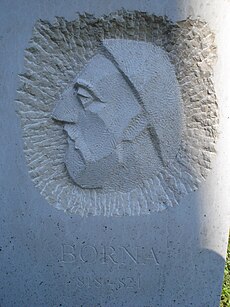Borna (Croatia)
Borna († 821 ) was a Slavic Knes and ruled over the Duchy of Croatia , the so-called Dalmatian Croatia , from 810 until his death in 821 . He was the son and successor of Višeslav and the first documented ruler of the Croats . Borna is credited with the Christianization of the coastal Croats, which was largely completed in the early 9th century . He took his seat in Nin .
Life
Domain
The territorial extent of Borna's domain cannot be determined with certainty. He is first in historical sources as " Dux of Guduscanorum" Duke Guduskaner referred (Croatian Gačaner), probably because his sphere inhabited by the Guduskanern area around the river Guduča , in Lika , in the valley of Gacka and the Kulpa included . The Guduskans were allies and direct neighbors of the Frankish Empire. The chronicler Einhard called Borna 818 as the "Duke of Guduskaner and timočani " and 819 as "Duke of Dalmatia". Nada Klaić writes: “He is dux Gudsucanorum and also dux Dalmatiae atque Liburniae. Franconian historians who use historical terms for areas in the Balkans and the Adriatic call him the princes of Dalmatia and Liburnia. "
Political situation
Borna, like his nephew and rival Ljudevit Posavski , had to pay tribute to the Franks . In contrast to Ljudevit, whose territory suffered particularly from the arbitrariness of the Margrave Kadaloch of Friuli , he behaved loyally to the Franks for political reasons, as he hoped they would protect and support against Byzantium .
After the death of Charlemagne , civil unrest broke out under his son and successor Ludwig in the Frankish Empire, which considerably weakened the emperor's power. This offered the counts and margraves of the empire the opportunity to become more and more independent. So also Kadaloch, who interfered more and more frequently in the internal affairs of the neighboring Slavic tribes and principalities, which up to now could decide independently. Kadaloch invaded the lands of Ljudevit and pillaged and pillaged there. After Ljudevit's complaint to the emperor had remained ineffective, he rose against the Franks, probably at the instigation of Byzantium; parts of the Carantans and Timotschans joined him.
Battle of the Kulpa (819)
Together with Ljudevit's father-in-law Dragomuž , Borna invaded Posavia from the south-east at the urging of Margrave Balderich of Friuli , Kadaloch's successor. Borna was defeated in the Battle of the Kulpa after the Guduskans had defected to Ljudevit. Dragomuž fell and Borna struggled to escape. Thereupon Ljudevit broke into the Dalmatian coastal area in December 819, where his army was exhausted by Borna's delaying tactics and the onset of harsh winter and finally forced to retreat. Borna managed to subjugate the Gačans again and to consolidate his power again.
Further armed conflicts against Ljudevit
In January 820 Borna went to Aachen , where he made an alliance with Emperor Ludwig and where it was decided to send three armies against Ljudevit, which were to be led by Borna, Balderich of Friuli and the Margrave Gerold . When the invasion troops appeared in Posavia in 820, Ljudevit avoided open field battles and withdrew to his mountain fortresses. The troops of Borna and the Franks devastated the country and then marched back. In view of the obvious superiority and destructiveness of the Franks, the rebellious part of the carantans surrendered to Balderich.
death
In the summer of 821, three invading armies again devastated the Posavians, who in turn avoided the decisive battle. Borna fell in the battle for one of the Posavian fortresses. He was followed by his nephew Vladislav .
literature
- Bogdan Binter: Zgodovina južnih Slovanov (History of the South Slavs). Ljubljana 1956.
- Ivo Goldstein: Hrvatski rani srednji vijek . Zagreb: Novi Liber [u. a.], 1995. (Historiae; 1).
- Hrvatski biografski leksikon . Vol. 2. Bj - C. Zagreb: Jugoslav. Leksikogr. Zavod Miroslav Krleža, 1989. p. 164. sv Borna .
- Nada Klaić: Povijest Hrvata u ranom srednjem vijeku (History of the Croats in the Early Middle Ages). Zagreb: Školska knjiga, 1975.
- Nada Klaić: Povijest Hrvata u srednjem vijeku (History of the Croats in the Middle Ages). Zagreb: Globus, 1990. ISBN 86-343-0472-8
- Trpimir Macan: Povijest hrvatskog naroda (History of the Croatian People). Zagreb: Školska knjiga, 1999. ISBN 953-0-61362-8
Web links
- nationmaster.com: Borna of Croatia. Retrieved September 8, 2013 .
- Thegan: Vita Hludowici Imperatoris . Retrieved September 8, 2013 .
See also
swell
- Borna. In: Hrvatska enciklopedija. Leksikografski zavod Miroslav Krleža, accessed December 30, 2019 (Croatian).
- Josip Lučić u. a .: BORNA. In: Hrvatski biografski leksikon. 1989, accessed December 30, 2019 (Croatian).
Individual evidence
- ↑ legati Abodritorum ac Bornae ducis Guduscanorum et Timocianorum
- ↑ Nada Klaić: History of the Croats in the Early Middle Ages . Zagreb 1975, p. 206.
| predecessor | Office | successor |
|---|---|---|
| Višeslav |
Prince of Dalmatian Croatia 810–821 |
Vladislav |
| personal data | |
|---|---|
| SURNAME | Borna |
| BRIEF DESCRIPTION | Croatian prince |
| DATE OF BIRTH | 8th century |
| DATE OF DEATH | 821 |

